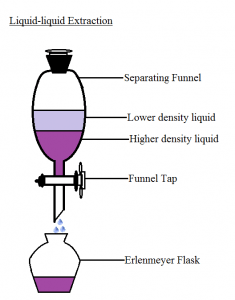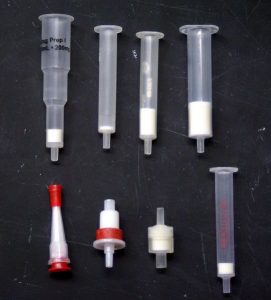A review of three commonly-used extraction techniques in laboratory-scale synthesis and analysis
Extraction – General Overview
What is extraction?
The process of extraction is a critical component of applied chemistry. Through extraction, it is possible to isolate specific molecules or classes of molecules from a complex mixture. In this article, we will restrict our discussion to three extraction techniques commonly used at the laboratory-scale. These are liquid-liquid extractions, supported-liquid extractions, and solid-phase extractions.
Extraction is an essential part of many chemistry applications, from processing environmental samples to purifying reactions in a laboratory setting. It is also used at many different scales, from milligram-size reactions in a research lab to kilo and ton scale in industrial settings.
How does extraction work?
Extraction hinges on the selective partition of molecules from either a liquid bilayer or a heterogeneous mixture. A liquid bilayer is made from the mixing of two immiscible solvents. On the other hand, a heterogeneous mixture is composed of a liquid and a solid supporting material.
The sample of interest will have a stronger interaction with one solvent or phase than the other. As such, when added to a mixture of different phases, the sample will preferentially dissolve or bind to that solvent or phase. Individual phases can be isolated, enabling the purification and concentration of your compound.
Many different variations of extraction procedures exist. These vary by several factors including selectivity, scalability, and cost. Environmental concerns may also play a role in the chosen extraction, especially when considering industrial-scale chemical processes.
Liquid-Liquid Extraction
Steps and General Procedure
As one of the simplest and straightforward extraction procedures, liquid-liquid extraction enjoys enduring popularity and is arguably the most common extraction method in chemistry.

(Source: https://commons.wikimedia.org/wiki/File:Liquid_liquid_extraction.png)
Liquid-liquid extractions follow a liquid-bilayer format. This bilayer is formed by the mixing of an organic and an aqueous solvent. The matrix containing the sample is usually first added as a part of the aqueous layer. Mixing of this generated bilayer will result in the analyte moving into the organic layer and the extraneous impurities and salts remaining in the aqueous layer. Additional organic layer additions will pull more and more analyte out of the aqueous layer. Additional washing steps may also be conducted, where the analyte-enriched organic solution is mixed with other aqueous solutions of different compositions to pull away impurities.
Benefits and Drawbacks
Liquid-liquid extraction has several advantages over more complex methods. For one, liquid-liquid extraction is easy to utilize and quite straightforward; all that is required is an organic and aqueous solvent, something to mix them in, and then something to isolate the layers. This last step can be done with a pipette for small volumes or out the bottom of a separatory funnel for larger volumes. Due to these factors, liquid-liquid extraction is a very common extraction method and is one of the first methods taught to undergraduate chemistry students. It is used extensively at small and large scales in the research, petrochemical, food, pharmaceutical, and hydrometallurgical industries.
There are a few disadvantages to this process. This extraction is effective only when the desired analytes preferentially dissolves in the organic solvent. As such, very polar molecules are incompatible with typical liquid-liquid extractions protocols. It can sometimes be tedious to separate the two layers accurately and emulsions can sometimes form. These emulsions need extra time and effort to remove, reducing laboratory efficiency. The requirement for large amounts of solvents can be an environmental concern as well as an explosive hazard, particularly at larger scales as seen in the industry. The selectivity of liquid-liquid extraction is also quite low, as all organic-soluble and not overly-polar compounds move into the organic layer. If a pure product is desired, further purification is typically required after liquid-liquid extraction.
Supported-Liquid Extraction
Steps and General Procedure
In this modification to liquid-liquid extraction, supported-liquid extraction involves dispersing the aqueous layer among fine, porous particles.
The aqueous layer containing the analyte of interest is first run through a column of diatomaceous earth. The analytes then adsorb onto the diatomaceous earth. As this material is polar, the more polar molecules will adsorb more strongly to the surface. After this, an organic solvent is added to the column. The solvent interacts with and carries away the weakly-bound molecules of interest. On the other hand, this also leaves the aqueous molecules that are more strongly embedded on the diatomaceous earth. This is advantageous, as most impurities are highly-polar or charged aqueous species.
Benefits and Drawbacks
Supported-liquid extraction has several benefits over liquid-liquid extraction. For one, this procedure is must easier to automate – no shaking or carefully pipetting off a single layer is required. The procedure only relies on moving of sample and solvent through a column, with the diligent separation of these different layers offers a quick and easy way to isolate and clean-up samples. As this extraction is cartridge-based, parallel processing of multiple cartridges provides an opportunity for increased throughput.
The main downsides for supported-liquid extraction originate from the consumable requirements. Commercially-produced extraction columns, which are typically single-use, are required for supported-liquid extraction, meaning increased funds are required to purchase these columns. The extra plastic use can also be an environmental concern. As well, pressure needs to be applied to move the solvent through the column. Generating this pressure usually requires additional equipment or infrastructure, which can increase costs and environmental concerns.
Solid-Phase Extraction
General Overview
When selectivity in the extraction is of the utmost importance, the discerning analyst turns to solid-phase extractions. Commercially available solid-phase extraction columns offer one of the largest available dynamic ranges in terms of analyte selectivity. The trade-off for this wide dynamic range for solid-phase extraction is that this process is a bit more involved than the two previously discussed methods.

(source: https://commons.wikimedia.org/wiki/File:SPE_Cartridges.jpg)
There are four distinct steps before the desired analyte is isolated, and relying on gravity to move material through the column is usually not an option. To move liquid through the column, a positive or negative pressure is usually required. The role of this pressure is twofold; not only does it push/pull the solvent through the column quicker, but it also acts as an efficient way to dry the column between steps.
Steps and Methodology
The first step in a solid-phase extraction is the conditioning of the column, where the dry packing material is pre-treated with a solvent or buffer to prepare for binding of the analyte-containing matrix. The second step is loading, where the mixture is added to and run through the column. In this step, the ideal scenario is that the analyte will selectively bind to the column packing material, but more often than not there will be some other undesired molecules that come along for the ride.
As such, a third step is almost always employed, where another solvent or buffer is run through the column. This liquid will bring the impurity into the solution but leaves the desired analyte still stuck to the column material. A final eluting solvent is then added. This solvent would remove the desired analyte from the column and into a receiving flask or tube. These steps can be expanded or omitted as desired. For example, there is the possibility that the desired analyte can be eluted while the
Benefits and Drawbacks
There are several advantages to solid-phase extraction. For one, the dynamic range available from commercially-available columns is truly remarkable. The selectivity of these columns range from general molecular classes to specific types of bio-molecules. For example, the spin-column method for DNA/RNA extraction is a solid-phase extraction process.
Other advantages include steps that are more easily automatable than a liquid-liquid extraction. The main reason for this is that no shaking or heating is typically required. Samples can also be concentrated significantly by running more solution through a cartridge. This means that sample concentration can occur without using heating or vacuum-assisted evaporation. Parallel processing is also possible by running multiple cartridges simultaneously, increasing sample throughput.
The downsides to SPE are the cartridges themselves and the method development aspects. As the cartridges are single-use and specially coated, costs can rack up quickly if multiple commercially-manufactured SPE cartridges are constantly required. Method development does require tuning of volumes, flow rates, and pressure to achieve optimal analyte extraction. This can take up significant time and resources, especially when dealing with new samples and their respective matrices. This is especially important considering that the extraction columns are single-use and can be expensive.
Have a liquid-liquid extraction, supported-liquid extraction, or solid-phase extraction protocol that you want to automate?
Aurora offers automation for all three of these extractions protocols with our VERSA 1100 workstation. Contact us if you wish to discuss how we can increase the throughput with our automated SPE, LLE, and SLE solutions.


